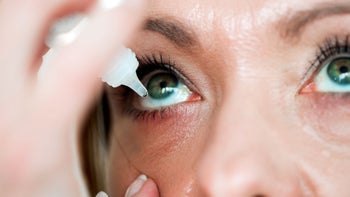
Do You Need Polarized Sunglasses? How to Find the Best Eye Protection for Summer
Key takeaways:
Sunglasses can protect the eyes from developing cataracts by blocking harmful ultraviolet (UV) light.
Polarized sunglasses limit glare, making it easier to see outdoors. But they may not include UV light protection.
Whatever type of sunglasses you choose, make sure they provide 100% UV protection or UV absorption up to 400 nanometers.
As the weather warms up, you may find yourself looking for a new pair of sunglasses. Sunglasses are more than just fashion accessories — they provide protection from harmful ultraviolet (UV) rays, which can damage your eyes.
And if you get migraines, wearing a pair of sunglasses can keep sunlight from triggering a headache.
There’s a dizzying array of sunglasses available for purchase. Some, like polarized sunglasses, are labeled for outdoor use. But which sunglasses really offer you the best protection? Let’s take a look at what you really need to look for when buying sunglasses.
Search and compare options
How are polarized sunglasses different from other sunglasses?
Polarized lenses limit glare. Glare makes it hard to see. Light bounces off surfaces like snow, water, and sand. This creates glare.
Polarized lenses filter out horizontal light rays so that images look clearer but slightly darker.
Polarized lenses can be helpful if you’re exposed to a lot of glare, which can lead to photokeratitis (snow blindness). They’re popular options for lifeguards, skiers, and sailors. Anyone who works or spends time on the water, beach, or in snow can benefit from polarized lenses.
People who have migraines triggered by light can also benefit from polarized sunglasses. For the best migraine prevention, look for polarized lenses and large frame sunglasses. FL-41 tinted lenses are rose-colored lenses that can help filter out blue-green light, which may help with migraine prevention.
What are the disadvantages of polarized sunglasses?
Polarized sunglasses don’t always contain UV light protection. That means they won’t protect your eyes against UV light.
They also make everything look darker.
Read more like this
Explore these related articles, suggested for readers like you.
This makes it harder to see images on a screen like your phone or car dashboard. Polarized sunglasses can also make it harder to see ice. If you’re driving in icy conditions or skiing, you may need to remove your polarized sunglasses.
If you have night blindness, there are polarized lenses marketed as night driving glasses. But experts warn that you shouldn’t use these for driving. They’re not proven to work and may further limit your vision by making images look darker.
How do sunglasses protect against UV rays?
Sunglasses shield your eyes and the skin around your eyes from harmful UVA and UVB rays.
UVA and UVB rays can damage the cornea (clear front of the eye) and lens (middle portion of the eye). This can increase the risk of developing eye conditions that can damage your vision like:
Since you can’t put sunscreen on your eyes, wearing sunglasses is the best way to protect the eyes against UV light. Both plastic and glass lenses offer UV light protection.
What should you look for when buying sunglasses?
Not all sunglasses are created equal. For the best protection, you need sunglasses that filter out as much UV light as possible.
Don’t assume that dark-colored sunglasses provide more protection. And more expensive pairs aren’t necessarily better either. Instead, rely on the UV protection label to help you pick out sunglasses.
Check sunglasses for labels that read:
100% protection against UVA and UVB light
UV absorption up to 400 nanometers (nm)
These labels mean that a pair of sunglasses filters out almost all UV light. They offer the best protection for your eyes.
If you’re using an older pair of sunglasses and you’re not sure if they offer UV protection, take your glasses to your eye doctor’s office or local eyeglasses store. They can test your sunglasses with a UV light meter to see if they offer UV light protection.
Other things to consider when choosing sunglasses include:
Choose polarized lenses with UV protection if you’re exposed to glare.
Consider oversized or wraparound sunglasses to protect your eyes from UV light entering from the sides.
Pick polycarbonate lenses if you play outdoor sports. They’re more durable and less likely to shatter.
Can health insurance pay for sunglasses?
Vision insurance may cover some (or all) of the cost of a pair of prescription sunglasses. If you don’t have vision insurance you may be able to use your health saving account (HSA) or flexible spending account (FSA) to help pay for prescription sunglasses. You should contact your plan sponsor before purchasing prescription sunglasses to make sure they’re an eligible expense.
Nonprescription sunglasses are not qualified medical expenses. That means you can’t use insurance, HSA, or FSA to cover the cost.
The bottom line
Navigating the sunglasses market can be tricky with all the available options . The most important thing to look for is UV light protection. Choose a pair of sunglasses marked as “100% UV light blocking” or “UV absorption up to 400 nm.”
If you spend a lot of time outdoors for work or fun, you can look for polarized sunglasses. Polarized lenses reduce glare and make it easier to see. Just make sure your polarized lenses also block UV light.
Why trust our experts?


References
American Academy of Ophthalmology. (2015). Recommended types of sunglasses.
Boyd, K. (2021). Tips for choosing the best sunglasses. American Academy of Ophthalmology.
Boyd, K., et al. (2022). What are polarized lenses for? American Academy of Ophthalmology.
Chalam, K. V., et al. (2011). A review: Role of ultraviolet radiation in age-related macular degeneration. Eye Contact Lens.
National Eye Institute. (2022). Protecting your eyes from the sun’s UV light.
Porter, D. (2022). What is ocular melanoma? American Academy of Ophthalmology.
Rauch, K. (2018). Night driving glasses may hurt, not help. American Academy of Ophthalmology.




























